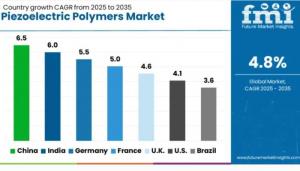Piezoelectric Polymers Market Predicted to Reach USD 2.9 Billion by 2035, Unlocking Growth Opportunity for Manufacturers
India’s piezoelectric polymers market grows at 6% CAGR, driven by medical, electronics & sensor demand, with rising local R&D and smart material adoption.
NEWARK, DE, UNITED STATES, August 18, 2025 /EINPresswire.com/ -- The global Piezoelectric Polymers Market is set to undergo a transformative decade, expanding from an estimated USD 1.8 billion in 2025 to USD 2.9 billion by 2035, at a steady CAGR of 4.8%. This shift marks not only a strong financial trajectory but also a profound evolution from legacy applications toward integrated, high-performance solutions across industries.
A Market Moving Beyond Stabilization
From 2025 to 2030, the market will see incremental growth, rising from USD 1.4 billion to USD 1.9 billion. While growth remains relatively steady in the early years, plateauing briefly in 2029, momentum accelerates post-2030. By 2035, the industry achieves a significant USD 1.0 billion gain in just five years, propelled by breakthroughs in energy harvesting, wearable electronics, and biomedical microdevices.
This trajectory highlights a transition: piezoelectric polymers are no longer confined to niche science but are rapidly becoming core components in application-engineered commercial systems, ensuring manufacturers long-term value creation.
Expanding Role Across Industries
The consumer electronics industry leads with a 25–30% share, leveraging piezoelectric polymers in smartphones, wearables, and tablets for haptic feedback, vibration sensing, and touch-sensitive controls. The automotive sector follows at 20–25%, with integration into pressure sensors, airbags, and noise/vibration control systems. In healthcare, which accounts for 15–20%, piezoelectric polymers are enabling ultrasound transducers, biosensors, and non-invasive diagnostic devices, thanks to their biocompatibility and flexibility.
Other significant contributors include:
• Industrial automation (15–18%) – robotics, motion control, and structural monitoring.
• Aerospace & defense (10%) – vibration damping, pressure sensors, and flight monitoring systems.
• Energy harvesting & smart textiles (5–7%) – powering self-sufficient devices.
• Acoustic & ultrasonic devices (5–7%) – sonar, ultrasonic cleaning, and welding tools.
This diverse application landscape illustrates how piezoelectric polymers are advancing flexible, energy-efficient, and miniaturized technologies across critical sectors.
Why Manufacturers Are Turning to Piezoelectric Polymers
The rise in demand is linked to low-power, lightweight, and flexible solutions. For manufacturers, piezoelectric polymers offer:
• Mechanical flexibility for seamless integration into curved and complex surfaces.
• Electromechanical efficiency that enhances device reliability.
• Thermal stability for challenging environments.
With consumer demand shifting toward smart, sustainable, and wearable technologies, piezoelectric polymers provide an essential pathway for manufacturers seeking to innovate and remain competitive.
Segmental Insights – Opportunities for Industry Leaders
Sensors Segment (38.5% by 2025):
As the leading application area, sensors showcase the greatest potential for manufacturers. Their role in wearables, structural health monitoring, and gesture recognition is expanding rapidly, supported by roll-to-roll processing compatibility for large-scale production.
Healthcare Segment (41.6% share by 2025):
This end-use segment dominates, with piezoelectric polymers enabling drug delivery, smart bandages, and implantable devices. With rising demand for real-time, non-invasive monitoring, manufacturers supplying the healthcare sector stand to gain significantly.
Polymers Product Segment (52.4% share by 2025):
Polymer-based materials, particularly PVDF and PVDF-TrFE, will remain the backbone of the industry. Lightweight, scalable, and high-performing, these polymers present manufacturers with cost-effective, sustainable alternatives to traditional ceramics.
Overcoming Industry Challenges
Manufacturers face the delicate task of balancing sensitivity and flexibility. While high-sensitivity copolymers generate stronger signals, they risk brittleness. Elastomer-based films offer flexibility but demand higher input force. Success lies in refining formulations and ensuring uniform performance through advanced processing techniques like corona poling and controlled annealing.
Key Growth Drivers
1. Wearable & IoT Devices – Energy harvesting in self-powered health patches, smart textiles, and IoT sensors.
2. Custom Composites & Partnerships – Collaborations enabling tailored solutions for aerospace, medical, and automotive applications.
3. Sustainability & Biocompatibility – Shifting preference from ceramic-based to eco-friendly, non-toxic polymer alternatives.
Regional Highlights
• China (CAGR 6.5%): Leading growth with high-volume adoption in robotics, energy harvesting, and consumer electronics.
• India (CAGR 6.0%): Innovation hubs and cost-effective processing support rising use in healthcare, agriculture, and smart infrastructure.
• Germany (CAGR 5.5%): Strong automotive and aerospace applications, with R&D driving next-gen sensors.
• France (CAGR 5.0%): Focus on aerospace, defense, and biodegradable materials for sustainability.
• UK (CAGR 4.6%): Smart infrastructure and AR/VR haptics are expanding demand for flexible polymer applications.
Competitive Landscape
The competitive dynamics favor both established players and emerging startups. Industry leaders like Arkema, Solvay, Daikin, and Kureha dominate resin production, while device-level competition revolves around sensor assemblies, flexible PCBs, and smart integration services. Emerging startups are pushing boundaries with inkjet-printable inks and advanced co-polymer solutions, positioning themselves as vital collaborators for manufacturers.
Manufacturers that can secure consistent quality, scalability, and tailored materials will gain a competitive edge in meeting the growing requirements of automotive, healthcare, and electronics OEMs.
Request Piezoelectric Polymers Market Draft Report:
https://www.futuremarketinsights.com/reports/sample/rep-gb-22988
For more on their methodology and market coverage, visit https://www.futuremarketinsights.com/about-us.
A Future Built on Intelligent Materials
The Piezoelectric Polymers Market is entering a new era, where flexibility, sustainability, and efficiency define success. For manufacturers, this is more than a growth forecast—it is an opportunity to reshape industries, build next-generation solutions, and capture untapped value across the global supply chain.
Related Insights from Future Market Insights (FMI)
Piezoelectric Ceramics Market - https://www.futuremarketinsights.com/reports/piezoelectric-ceramics-market
Biopolymers Market - https://www.futuremarketinsights.com/reports/biopolymers-market
Sulfone Polymers Market - https://www.futuremarketinsights.com/reports/sulfone-polymer-market
Drilling Polymers Market - https://www.futuremarketinsights.com/reports/drilling-polymers-market
Acetal copolymers Market - https://www.futuremarketinsights.com/reports/acetal-copolymers-market
Editor’s Note:
The piezoelectric polymers market is rapidly evolving, driven by innovations in flexible electronics, medical devices, and smart sensors. With rising demand for lightweight, adaptable, and energy-efficient materials, the sector is witnessing strong growth opportunities. This report highlights key trends, demand drivers, and future prospects shaping the industry landscape.
Rahul Singh
Future Market Insights Inc.
+1 347-918-3531
email us here
Legal Disclaimer:
EIN Presswire provides this news content "as is" without warranty of any kind. We do not accept any responsibility or liability for the accuracy, content, images, videos, licenses, completeness, legality, or reliability of the information contained in this article. If you have any complaints or copyright issues related to this article, kindly contact the author above.
Sisecam’s Consolidated Net Sales Reached 101 Billion TL in the First Half of the Year
Quantum Catalyst Market is Expected to Reach a Valuation of USD 7,930 Million in 2035, Says Fact.MR.
Food Vacuum Drying Machine Market Demand Rising at a Stellar 5% CAGR to Reach USD 2.3 Billion by 2035: Fact.MR Report
Więcej ważnych informacji
 Jedynka Newserii
Jedynka Newserii

 Jedynka Newserii
Jedynka Newserii

Konsument

Wzrost sprzedaży piw bezalkoholowych idzie w parze z inwestycjami w zieloną energię. Kompania Piwowarska ogranicza ślad węglowy i wspiera lokalne inicjatywy
Kompania Piwowarska kontynuuję realizację strategii „Lepsza Przyszłość 2030”, w której łączy ambitne cele środowiskowe, edukacja konsumentów oraz rozwój segmentu piw bezalkoholowych z realnym wsparciem dla lokalnych społeczności. Firma, będąca liderem polskiego rynku piwa, ogranicza emisję CO₂, zwiększa udział opakowań zwrotnych i angażuje pracowników w wolontariat, w tym m.in. w pomoc dla ofiar powodzi na Dolnym Śląsku.
Handel
D. Joński: Europa musi chronić swój rynek poprzez cła i wysokie standardy bezpieczeństwa dla importowanych towarów. Powinniśmy budować własny przemysł oparty na tańszej energii

Tańsza energia, a przez to niższe koszty produkcji w Europie to jeden z kierunków, który wskazuje Unia Europejska w rywalizacji z tanimi towarami z Azji, głównie z Chin. Jednocześnie rynek Starego Kontynentu powinien być chroniony poprzez zbalansowane cła oraz wysokie standardy bezpieczeństwa stawiane importowanym produktom. Zdaniem europosła Dariusza Jońskiego ważne jest rozwijanie przemysłu w Europie bez względu na narodowość właścicieli. Relacje z Chinami muszą zostać na nowo zdefiniowane i przebiegać na równych zasadach.
Handel
Poprawia się jakość raportów dużych spółek giełdowych dotyczących zrównoważonego rozwoju. Pozostają też obszary do dopracowania

Ekspertki i eksperci z Deloitte’a przeprowadzili analizę ujawnień taksonomicznych spółek notowanych na Giełdzie Papierów Wartościowych, która objęła sprawozdania z działalności za rok 2024 w części dotyczącej zrównoważonego rozwoju. To trzeci rok ujawniania stopnia zgodności przedsiębiorstw z Taksonomią Unii Europejskiej, co przekłada się na zwiększoną jakość i porównywalność prezentowanych danych. Jednocześnie można oczekiwać, że inwestycje zgodne z Taksonomią będą coraz istotniejszym elementem strategii rozwoju przedsiębiorstw w kolejnych latach.
Partner serwisu
Szkolenia

Akademia Newserii
Akademia Newserii to projekt, w ramach którego najlepsi polscy dziennikarze biznesowi, giełdowi oraz lifestylowi, a także szkoleniowcy z wieloletnim doświadczeniem dzielą się swoją wiedzą nt. pracy z mediami.










.gif)

 |
| |
| |
|